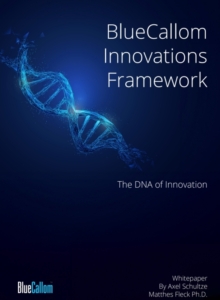The biggest leap in Software since its inception.
BlueCallom has developed early versions of Agents since 2021. Back then, we called it multifunctional Prompts. They were using GPT 3. This was over a year before ChatGPT was released.
Our prompt engineering skills advanced pretty quickly, yet the results and the technology around it were still very rudimentary, so we started building a code-based infrastructure to let prompts send email, convert results into PDFs, create icons with Dall-E for each prompt, and created access to all kinds of APIs.
In 2022/23, we experienced a slight change in our own thinking. We thought more often about what would the most knowledgeable person on earth ask us before he or she would answer our questions. We created conditional prompts, editable results for additional iterations, and other prompt types.
When ChatGPT was announced and the new GPT3.5 and its new API structure were released, we understood that this technology would create a seismic shift over the next 5 years. It would allow us to build highly sophisticated business solutions that no software company could build with conventional software.
The Agentic Leap Explained
1) Forget prompting as you know it
Prompts are the most strategic direct connection between the core of an agentic AI and the human brain. We explained that in-depth in many keynotes, on our website, and on blog posts. Very much like we find thoughts or compose ideas, an AI can find results within LLMs and, more importantly, can compose ideas with a quality that is far beyond what a human brain can. Our 4 years of neuroscience study helped us understand how thoughts are composed (David Eagleman PhD, neuroscientist, Stanford). We then build the bridge to breakthrough ideas. The global knowledge that is hosted in an LLM like OpenAI o1 has many times the experience repertoire than even the most knowledgeable human. So why not just give up on searching for ideas when we can tap into a super-experienced artificial brain? That’s what we decided to do. But the prompts we had to write had nothing to do with the initial prompts we had written back then. Why? If I ask the most knowledgeable AND most creative person on earth to give me a breakthrough idea, that person would ask a ton of questions before he or she could answer, and even then, he or she would run quite some routines in their brain because an answer could be developed. So prompts need true prompt engineering, but the results are stunning, to say the least. We created a new way to build geothermal energy plants and other innovations.
Leveraging that intelligence power would be impossible with any software whatsoever. It’s not about the computational speed, simplifying writing books, or processing emails. The new gold is exclusively about INTELLIGENCE. And like in the old gold rush, getting the gold out was still a very tough job.
2) Agents & Multi-Agents
Writing complex tasks with a prompt, as we know it from ChatGPT, is pretty much hopeless. For complex processes of any kind, we need multiple prompts. And the best way is to pack them into Agents. Agents not only allow the connection of multiple prompts but also solve the problem of memory management. Where and how will we store all the intermediate results? How do we use them later? We are not storing simple phone numbers, names, products, part numbers, prices, and so forth. We are storing intelligent responses, though, chains of thoughts, complex relationships, and multi-dimensional scenarios. As we developed ways to connect prompts, we are connecting agents with a similar protocol structure.
Agentic AI is a mindset
We learned to rethink and even reimagine everything. We must let go of the stiff and narrow structured software code and open up for the more complex but significantly more powerful prompts. Unlike conventional software code, it is much easier to make a solution learn. For instance, learn from user feedback, learn from certain KPIs, learn from user behavior, and more. It is very easy to ask it for reasons why this or that suggestion was made. New knowledge will be made available centrally at the LLM level without rewriting a single line of code. It’s all about trading a known but linear and narrow path of coding with sheer intelligence already in the process operation itself.
3) Agentic AI Solutions
Let’s take it to the next level. Now, into 2025. Agentic AI business solutions are here. Multiple Agent networks collaborate, for instance, in an Autonomous Innovation system that can create breakthrough innovations within hours. That is already a reality. Another Agentic AI Business Solution assesses a bank and its annual reports plus a few not publicly available data and can develop a strategy to bring the cost-income ratio (CIR) down below 50%. It also provides a plan with all the detailed steps to get there. And if that is not enough, it can help create all the agents that work on the process until the goal is achieved.
Also, this solution exists already today. Another solution is a TRANSFORMATION solution that analyses each and every workplace and looks for improvements and ways to help employees get rid of burning tasks and time sinks. Then, tasks can be delegated to AI agents. Employee Suggestions have been a painful process in the past. Who wants to review thousands of suggestions knowing that at least 50% are so purely articulated that it would be impossible to make sense of them? The new TRANSFORM solution is intelligent enough to read a human suggestion right after it is submitted and respond by reflecting on the suggestion, rephrasing it, and asking if that was understood right. Only then it will be processed. The next step includes intelligent assessments, finding groups of issues, looking for connections and root causes, and eventually suggesting solutions. As mentioned before, t0 could create the blueprints to develop the solutions. Clearly, there is no way to develop those mission-critical applications with conventional software.
4) Intelligence
Every step in a new Agentic AI solution can be driven by intelligence. Many actions can be performed autonomously – not just the process but the entire operation of that solution. Imagine a product is identified as having a wrong SKU. An AI system would immediately understand and be able to auto-correct it. Yes, an algorithm could do that, too – but one would need millions of algorithms for every possible case. Bugs in logistics flows, flexible onboarding processes, quality assurance processes, RMA processes, … the list is far beyond the scope of this explanation. In any case, pretty much any aspect of a modern organization is dealing with those challenges as growth and speed has outgrown the human capacity to comprehend all aspects of those issues. And finger pointing on “bad data” and “garbage in – garbage out” is not helpful. Even the attempt to make a massive data cleanup is not working. Why? Because it takes less than 90 days and you are back to data garbage.
The end of data garbage in – garbage out
Today’s data models are rigid and inflexible. Large organizations must be super dynamic, fast responsive, and able to adapt ever faster. Rigid IT structures are one of the biggest obstacles. How will that be handled 10 or 20 years from now? Sure, by somebody else. But that is not an acceptable solution. Rigid data structures and rigid code development will be unacceptable for modern companies. We need highly intelligent designs for building solutions, data models, workflows, and human interactions with IT results. While business application software manufacturers are working feverishly to bring their solutions to an all-new level, a completely new market is opening up. This is the market of AAIS Class Solutions.
AAIS Class Solutions
Today, we have ERP, CRM, CNC, and many other corporate software solutions. All have the same behavior: Someone needs to enter data, which can then be retrieved, or somebody else can access the data.
AAIS Class Solutions or Applications work profoundly differently. Instead of humans entering or retrieving raw data, users can now elevate their perspective and manage agents who perform that job for them. However, this would still be similar, just with fast middlemen and lots of managers.
The far more exciting future is to build solutions that were simply impossible with conventional software. For instance, the complexity of driving the CIR of a Bank below the 40% mark. This would be impossible for conventional software. But not for Agentic-AI. And we know it’s possible because we already built such a solution. Another such AAIS Class Solution is our TRANSFORM product. Instead of searching for Agentic AI use cases, TRANSFORM does that job for you. Again, here, the complexity of analyzing thousands of workflows is impossible for conventional software or is cost-prohibitive, but an Agentic AI solution is intelligent enough to perform such tasks. You will be able to test in the next few weeks. Currently, we have three AAIS Class Solutions ready to deploy, and we have 14 more of those enterprise-grade solutions in the pipeline for this year.
Talking about enterprise-grade: The BlueCallom platform can handle corporations with an HQ structure, multiple country organizations, different business units, and countless departments. The business model is also new, as there is no per user per month license necessary. Companies can add as many users as they like, including external supporters, customers, and business partners. AAIS solutions are pay-per-use in different versions, including a pay-per-run version. The Autonomous Innovation solution can be paid per run – and once the results are delivered simply quit – no matter if it takes 2 days or 2 years.
The quantum Leaps we already made with AAIS Class Solutions.
Get Strategic
Don’t think of Agentic AI as a new software. It is no software. Software was already abstract enough, but one could read code, buy discs or at least download it. Agentic AI is, first and foremost, “Intelligence” that is available to you. Your prompt or audio interaction is a dialog with a highly intelligent nonbiologic being. What you get in return are intelligent solutions in the form of better processes, delegated tasks, visuals, and so forth.
Use Cases
Rather than thinking about what would be a good place to start, let the AI come up with options. Solve real problems instead of conducting random experiences. There are a few agents and the BlueCallom TRANSFORM multi-agent solution available to help you identify areas where prompts or entire solutions would make sense..
Test it Yourself
Arrange a call with our team to see if we are all on the same page; if it is a great use case for you, we are more than happy to help you on the cost side. We will walk you through what is going on and provide you with the necessary credits (CallomCoins) to run a first try at no cost. It may well be the only one run that you need to make already a first impact.





